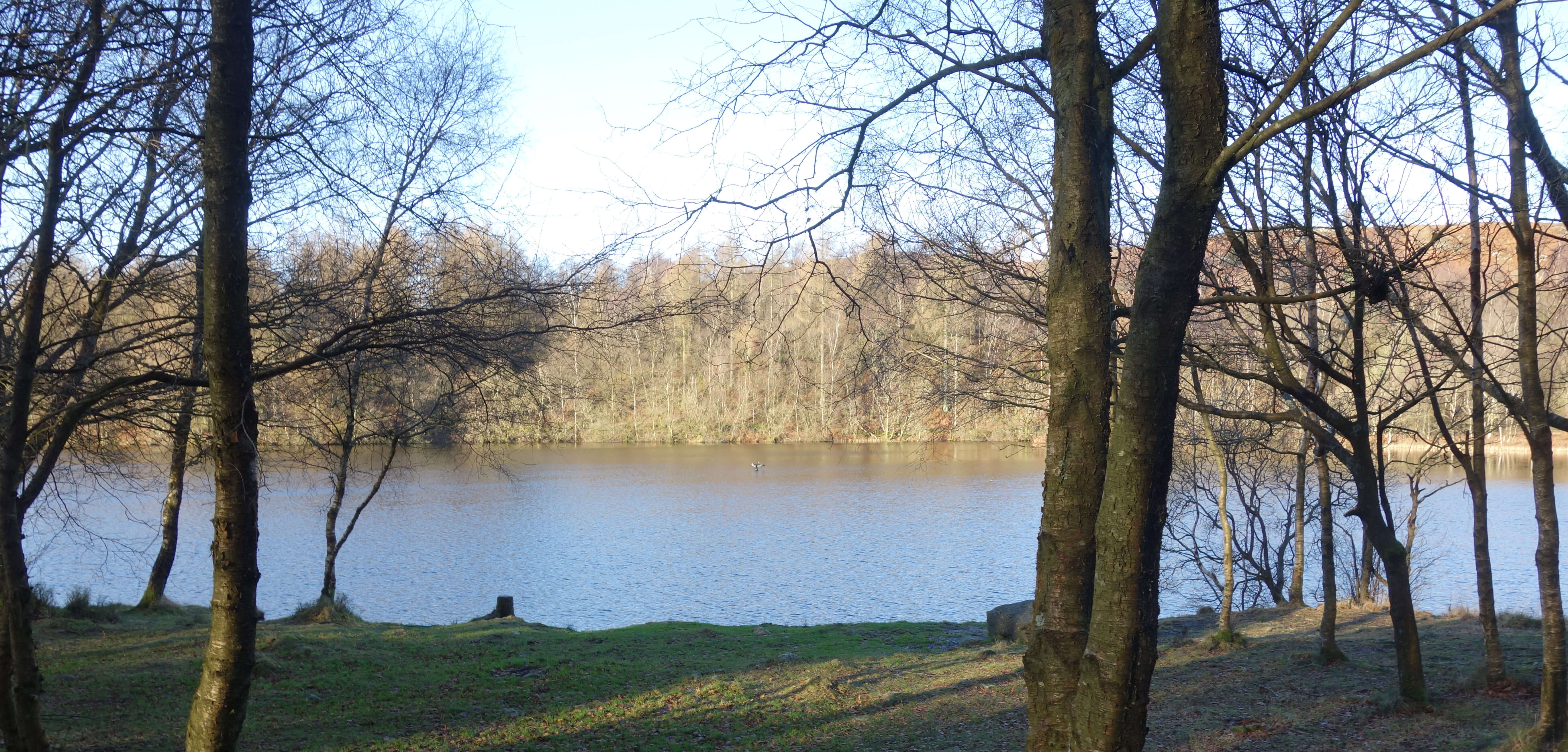

Home Preamble Index Areas Map References Me Drakkar
 Left: High Dam.
Left: High Dam.

North from Great Green Hows, to Green Hows Upper Tarn and, on the horizon, the Langdale Pikes, Helvellyn and Fairfield (in cloud), Red Screes and High Street
I headed south over Rusland Heights. The scrubby, hummocky, heathery land was criss-crossed by a maze of what-might-be-paths. The bearing was clear but the path less so, until I realised that white topped posts marked the way. There was a post every few yards, which was very kind of whoever put them there. Two jets flew past, ruining the silence. Their sound reverberated around the hills for some time as they made their way along various dales.
Towards the Scafells from Rusland Heights
The white posts led me down through Yewbarrow Wood heading, it seemed, for the Rusland valley, where many fields were flooded. The trouble with following posts – or indeed people – is that they may not be leading you where you expect them to. But my lapse of faith proved unfounded because I emerged at the road at the exact point necessary to take the path east to Town End. Walks through woods are always pleasant but I never find that I have much to say about them. Stark trees, at this time of year; sprinkles of sunlight on dead leaves; luxuriant mosses covering the rocks; a few birds twittering in the tree tops.
Windermere from Lakeside, Gummer's How on the right
After walking through Great Knott Wood, I reached Lakeside to find that they were preparing to move the afore-mentioned big boat, which I now noticed was parked or berthed in the second car park. How they got this boat over Newby Bridge, along the narrow roads, and into the car park I don’t know. It looked more like a ferry-boat than a privately-owned boat. Perhaps they are upgrading the boats used for the cruises, to cater for even more trippers. (**)
2018 2017 2007 1988
Windermere Lake Cruises 1. 1,634,654 1. 1,611,491 1. 1,274,976 1. 520,060
Ullswater Steamers 2. 448,820 3. 414,777 7. 187,469
The Rheged Centre 3. 440,178 2. 423,908 2. 465,452
Grasmere Gingerbread 4. 250,000 7. 200,000
Lakeside and Haverthwaite Railway 5. 220,014 8. 198,377 6. 85,000
The World of Beatrix Potter, Bowness 6. 205,258 9. 191,590
Tullie House Museum and Art Gallery 7. 204,912 6. 204,854 3. 279,889 14. 55,000
Ravenglass and Eskdale Railway 8. 204,500 2. 250,000
Whinlatter Forest Park & Visitor Centre 9. 196,294 5. 237,499 8. 187,269 11. 74,500
Carlisle Castle 10. 174,171 18. 53,407 13. 57,495
Grizedale Forest Park and Visitor Centre 11. 169,395 10. 183,900 5. 231,500
Carlisle Cathedral 12. 149,637 11. 157,742 9. 152,138
Lowther Castle and Gardens 13. 119,085 13. 110,000 7. 84,000
Theatre By The Lake, Keswick 14. 112,397 14. 107,790 10. 108,598
Hill Top, Beatrix Potter’s House 15. 110,206 12. 119,044 5. 90,000
Wray Castle 16. 103,900 15. 95,829
Lakeland Motor Museum, Backbarrow 17. 76,068 16. 78,850 17. 43,209
Muncaster Castle 18. 60,570 18. 64,772 20. 39,553
The Puzzling Place, Keswick 19. 49,077 19. 47,716
Beatrix Potter Gallery, Hawkshead 20. 41,212
Lake District Visitor Centre, Brockhole 4. 293,437 11. 108,530 4. 98,000
Tree Top Trek, Brockhole 17. 72,637
Dove Cottage and the Wordsworth Museum 20. 46,029 15. 61,870 8. 80,400
South Lakes Wild Animal Park 4. 252,631
Aquarium of the Lakes, Lakeside 6. 229,342
Cumberland Pencil Museum, Keswick 12. 85,000 10. 75,000
The Dock Museum, Barrow 13. 70,563
Wetheriggs Country Pottery, Penrith 14. 65,000 15. 50,000
Northern Lights Gallery, Keswick 16. 60,000
The Teapottery, Keswick 17. 56,350
The Homes of Football, Ambleside 19. 53,000
Lake District Coast Aquarium, Maryport 20. 46,972
Sellafield 3. 148,000
Holker Hall 9. 80,100
Border Regiment Museum, Carlisle 12. 58,621
Levens Hall 16. 47,701
Windermere Steamboat Museum 18. 40,236
Sizergh Castle 19. 40,000
** Since writing the above I have found that the vessel is indeed a new addition to the Windermere Lake Cruises’ fleet. This
website
gives details of its construction and, at the time of writing, of its ‘soft launch’ on December 11.
Home Preamble Index Areas Map References Me Drakkar
© John Self, Drakkar Press, 2018-

Top photo: The western Howgills from Dillicar; Bottom photo: Blencathra from Great Mell Fell